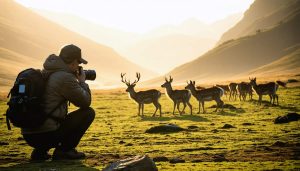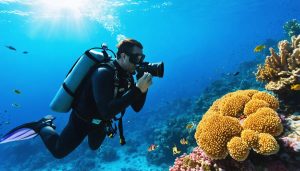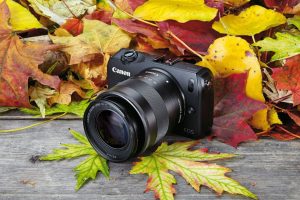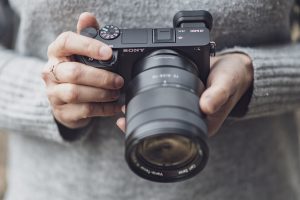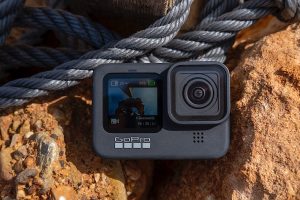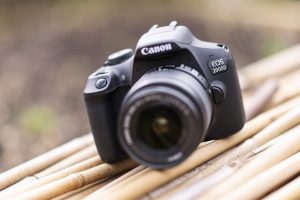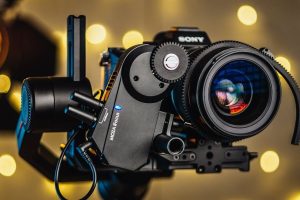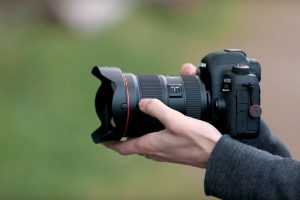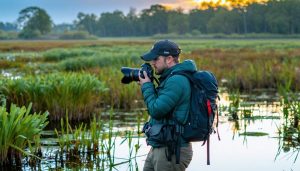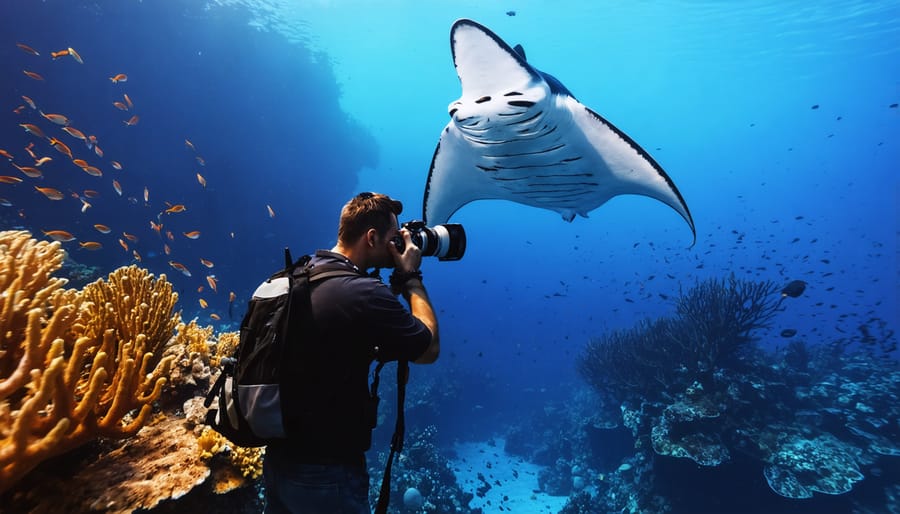
Beneath the surface of our oceans lies a photographer’s paradise where patience, preparation, and passion converge to capture extraordinary moments in marine life. From the graceful dance of manta rays to the vibrant communities of coral reefs, marine wildlife photography represents not just an artistic pursuit, but a powerful tool for ocean conservation.
The art of photographing marine wildlife demands a unique blend of technical expertise and environmental understanding. Every frame tells a story of survival, adaptation, and the delicate balance of underwater ecosystems. As climate change and human activities continue to threaten marine habitats, photographers stand as vital witnesses, documenting both the beauty and vulnerability of our ocean’s inhabitants.
Modern marine wildlife photography has evolved beyond simple documentation. Today’s photographers combine cutting-edge underwater camera systems with advanced diving techniques to capture images that inspire action and awareness. Whether hovering motionless beside a curious sea turtle or waiting hours for the perfect shot of a spawning event, these visual storytellers bridge the gap between the mysterious underwater world and a global audience increasingly concerned about marine conservation.
For those drawn to this challenging yet rewarding field, success requires more than just mastering camera settings and diving skills. It demands developing a deep respect for marine life, understanding animal behavior, and adhering to strict ethical guidelines that prioritize the welfare of marine subjects over the perfect shot. This commitment to responsible photography ensures that our pursuit of compelling images contributes to, rather than compromises, marine conservation efforts.
Essential Gear for Underwater Conservation Photography
Underwater Camera Housing Systems
A reliable underwater housing system is the cornerstone of successful marine wildlife photography. These specialized enclosures protect your camera from water damage while maintaining full access to essential controls. When selecting underwater photography gear, the housing system should be your primary consideration.
Modern housings typically come in two varieties: hard-shell cases made from durable aluminum or polycarbonate, and flexible bag-style housings. Hard-shell cases offer superior protection and depth ratings, often allowing photographers to work at depths of 130 feet or more. These housings feature precision-engineered control buttons, knobs, and levers that correspond to your camera’s functions.
The heart of any housing system lies in its seals. Double O-ring seals are industry standard, creating redundant barriers against water intrusion. Before each dive, it’s crucial to inspect these seals for debris, damage, or wear. Many professional photographers carry a small maintenance kit with spare O-rings, silicone grease, and cleaning tools.
Most housings include moisture detection systems that alert you if water breaches the seals. Some advanced models feature vacuum systems that test the housing’s integrity before entering the water. These safety features provide peace of mind when working with expensive camera equipment in challenging marine environments.
Port systems are another vital component, allowing you to use different lenses while maintaining optical quality. Dome ports are ideal for wide-angle photography, while flat ports work better for macro shots of smaller marine life.
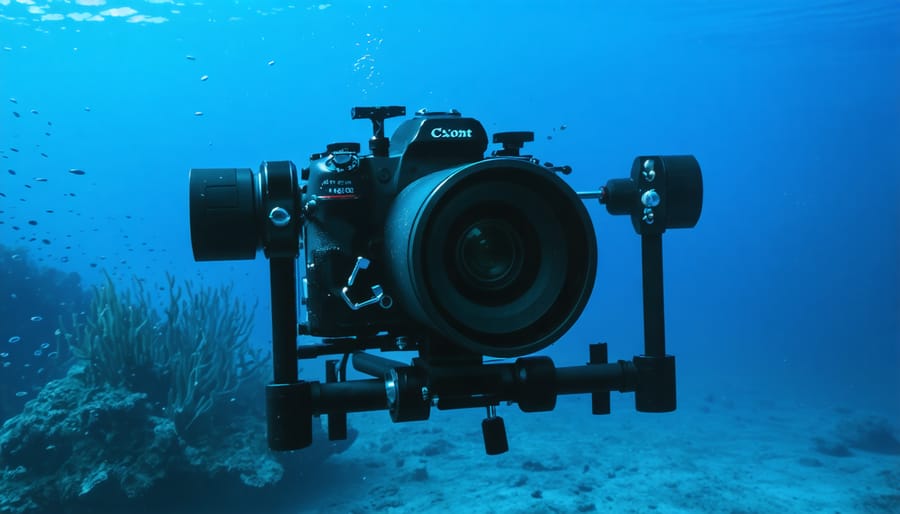
Lighting Equipment for Marine Photography
Proper lighting is crucial for capturing stunning marine wildlife images, and understanding various lighting techniques for underwater photography can dramatically improve your results. Let’s explore the essential lighting equipment you’ll need for successful marine photography.
Strobes are the workhorses of underwater photography, providing powerful, controlled bursts of light that help freeze motion and restore true colors lost at depth. Most photographers use a dual-strobe setup, which offers better coverage and helps eliminate harsh shadows. Position your strobes at 10 and 2 o’clock relative to your camera for optimal results, and remember to adjust power settings based on your subject’s distance and the water conditions.
Video lights have become increasingly popular, especially for macro photography and videography. These continuous light sources allow you to see exactly how your lighting will affect the shot before you take it. Modern LED video lights offer excellent color rendering and long battery life, making them perfect for extended diving sessions. Many photographers combine video lights with strobes for maximum versatility.
Natural light shouldn’t be overlooked, particularly when shooting larger subjects like whales or dolphins near the surface. The best natural light shots often occur during the “golden hours” – early morning or late afternoon – when sunlight penetrates the water at an angle. Using a combination of natural light and artificial lighting can create stunning effects, especially for split-shots that capture both above and below the waterline.
When choosing lighting equipment, consider factors like beam angle, power output, and recycle time. For beginners, a single strobe with a wide beam angle (100 degrees or more) is a good starting point. As you advance, you can add a second strobe and experiment with different lighting configurations to achieve more creative effects.
Remember that water absorbs light quickly, so position your lights as close to your subject as possible while maintaining proper coverage. This helps reduce backscatter and ensures your subjects are well-illuminated without overexposing the scene.
Ethical Approaches to Marine Wildlife Photography
Minimizing Environmental Impact
As underwater photographers, our primary responsibility is to protect the marine environments we document. The key principle is simple: observe and photograph while leaving no trace of our presence. This requires both technical skill and environmental awareness.
Maintaining proper buoyancy control is essential. Stay at least three feet away from coral reefs and other delicate marine structures to avoid accidental contact. Even the slightest touch can damage decades of coral growth. Practice your buoyancy skills in open water before attempting to photograph near sensitive ecosystems.
Never chase, touch, or feed marine life to get a shot. Instead, position yourself thoughtfully and wait for natural behaviors to unfold. This patience not only yields more authentic photographs but also ensures you’re not disrupting natural feeding, mating, or social patterns.
Consider your lighting carefully. While artificial lighting is often necessary underwater, excessive use of powerful strobes can stress marine life. Use the minimum amount of light needed for your shot, and avoid rapid-fire photography with strobes. If you notice animals showing signs of distress, such as erratic swimming patterns or defensive postures, back away slowly and give them space.
Your choice of diving gear matters too. Ensure all equipment is properly secured to prevent it from dragging across the seafloor or getting caught on coral. Choose reef-safe sunscreen if shooting in shallow waters, as common sunscreen chemicals can harm coral reefs.
The timing of your shoots can also impact marine life. Research breeding seasons and feeding patterns of your intended subjects, and avoid disturbing these crucial activities. Early morning or late afternoon sessions often provide the best natural light while minimizing impact on marine creatures’ daily routines.
Remember that you’re not just creating images – you’re documenting ecosystems that need protection. Consider sharing your photos to support marine conservation efforts, but always include information about responsible photography practices to inspire others to follow suit.
Safe Distance Guidelines
Maintaining a safe and respectful distance from marine wildlife isn’t just about getting the perfect shot – it’s about protecting these magnificent creatures and their habitats. As a general rule, stay at least 50 feet (15 meters) away from most marine mammals and sea turtles. For larger species like whales, maintain a distance of at least 100 yards (91 meters).
Different regions and marine protected areas may have specific regulations, so always research local guidelines before your shoot. In Hawaii, for instance, it’s illegal to approach spinner dolphins within 50 yards, while Australia requires keeping 100 meters away from whales during migration season.
Remember that marine animals often interpret direct approaches as threatening behavior. Instead, position yourself parallel to their expected path and let them choose to come closer if they wish. If an animal shows signs of distress – such as changing direction, increasing speed, or displaying defensive behaviors – you’re too close and should back away slowly.
When photographing from boats, maintain a steady, predictable course rather than making sudden movements. Never chase or harass marine life for a photo opportunity, and always give animals a clear escape route. If you’re diving or snorkeling, avoid touching or disturbing coral reefs, as they’re extremely fragile ecosystems.
For underwater photography, wide-angle lenses allow you to capture stunning images from a greater distance, reducing the need to get too close. Using a zoom lens from a boat can also help you maintain safe distances while still achieving intimate portraits.
Consider the timing of your shoots as well. Many marine species are most active during feeding or breeding seasons, when they’re particularly sensitive to disturbance. During these times, it’s crucial to be extra cautious and potentially increase your minimum distance to avoid causing stress or disrupting natural behaviors.
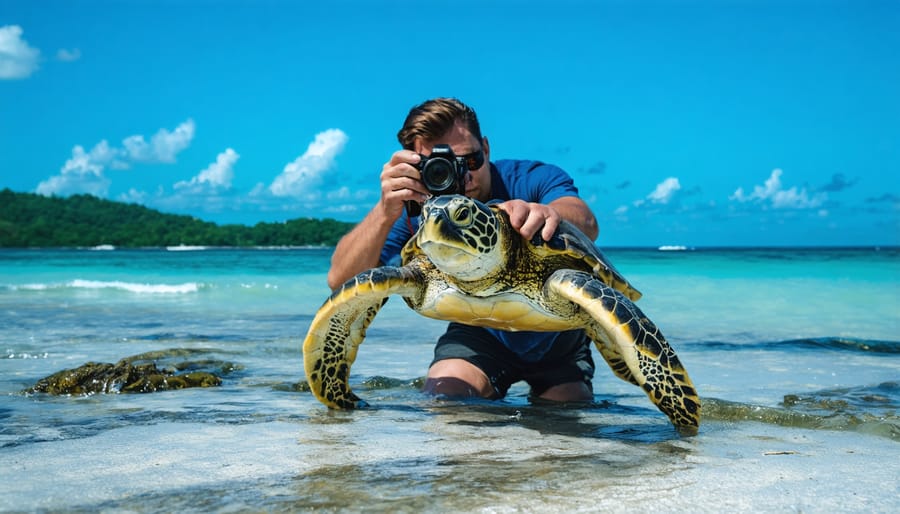
Technical Skills for Conservation Photography
Camera Settings for Underwater Conditions
Getting the right camera settings for underwater photography can make the difference between a murky blur and a stunning marine wildlife shot. In clear tropical waters, start with an aperture between f/8 and f/11 to maintain good depth of field while capturing sharp details. For faster-moving subjects like dolphins or sea turtles, use a shutter speed of at least 1/250th second to freeze motion.
When shooting in darker or deeper waters, you’ll need to adjust accordingly. Open up your aperture to f/4 or f/5.6 and increase your ISO to 800 or even 1600, depending on your camera’s capabilities. However, be mindful that higher ISOs can introduce noise, especially in the blue water background.
White balance is crucial underwater, as water absorbs different wavelengths of light at varying depths. While you can shoot in RAW and adjust later, starting with a custom white balance setting around 6500K can help you better evaluate your shots while diving. Consider using manual focus in murky conditions, as autofocus might struggle to lock onto subjects.
For macro photography of smaller creatures like nudibranchs or seahorses, switch to apertures between f/16 and f/22 to maximize depth of field, as getting close to your subject is essential. Use strobes or underwater lights to bring out the vibrant colors that get lost at depth, positioning them at 45-degree angles to minimize backscatter.
Remember that these settings are starting points – conditions can change dramatically even during a single dive. Practice adjusting your settings quickly and be prepared to adapt to changing light, visibility, and subject behavior.
Composition Techniques
Composing powerful marine wildlife images requires a thoughtful approach that goes beyond simply capturing the subject. The rule of thirds remains a fundamental principle, but marine environments demand additional considerations. Position your subject’s eyes along these gridlines and leave space in the direction they’re moving or looking to create a sense of motion and environment.
Consider the unique qualities of underwater compositions. Water creates natural layers, which you can use to add depth to your images. Position yourself slightly below your subject when possible, shooting upward to capture the beautiful contrast between the creature and the water’s surface. This angle often creates stunning silhouettes and captures the interplay of light rays filtering through the water.
Negative space plays a crucial role in marine photography. Don’t feel compelled to fill the entire frame with your subject. Sometimes, showing a small creature against the vast blue ocean tells a more compelling conservation story than a tight crop. This technique helps convey the animal’s place within its ecosystem and its vulnerability in the vast ocean.
When photographing coral reefs or stationary marine life, look for natural frames created by coral formations or rock structures. These elements can guide the viewer’s eye to your subject while providing context about the habitat. For moving subjects like dolphins or whales, anticipate their behavior and compose your shot to capture both the action and the environment.
Remember that compelling conservation photography often means showing the relationship between species and their habitat. Include environmental elements that tell a fuller story about the ecosystem and the challenges these creatures face.
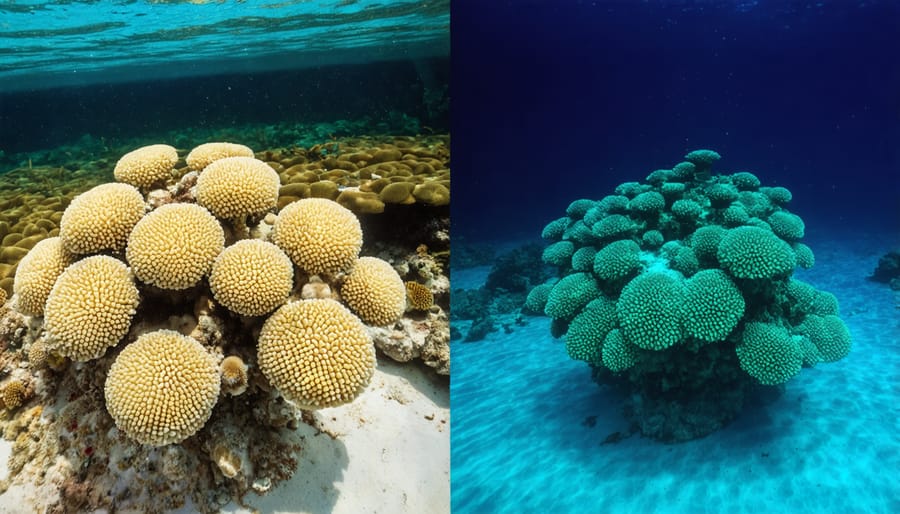
Post-Processing for Conservation Impact
Post-processing marine wildlife photographs requires a delicate balance between enhancing visual impact and maintaining authenticity. The goal is to showcase marine life in a way that moves viewers to care about conservation while staying true to reality.
Start with basic adjustments like white balance correction, especially important for underwater shots where colors can appear muted or blue-cast. Adjust exposure and contrast to reveal details in shadows and highlights, but avoid pushing these too far as it can make images look artificial. When working with RAW files, careful recovery of shadow details can reveal hidden marine life behaviors without compromising image integrity.
Focus on techniques that enhance natural elements: subtle clarity adjustments to bring out textures in coral reefs, selective sharpening to emphasize important features like a sea turtle’s eyes, or gentle color vibrance adjustments to restore the natural brilliance of tropical fish. However, resist the temptation to oversaturate colors or dramatically alter the scene’s natural appearance.
For conservation storytelling, consider developing a consistent editing style that emphasizes the beauty of healthy marine ecosystems while also documenting environmental challenges. When processing images of marine pollution or habitat destruction, maintain accuracy while ensuring the message remains clear and impactful.
Always include accurate metadata and caption information, noting any significant editing decisions that might affect the viewer’s understanding of the scene. This transparency builds trust and strengthens the conservation message behind your work.
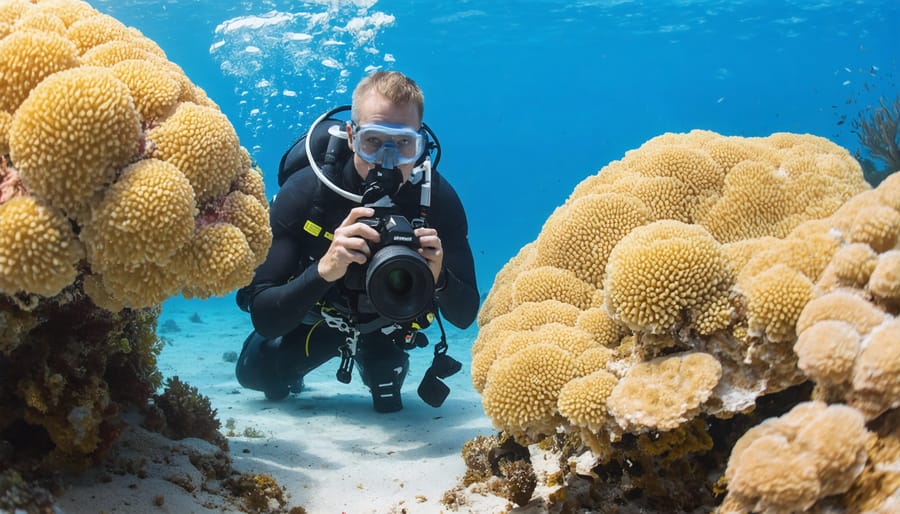
Contributing to Conservation Efforts
Marine wildlife photography plays a crucial role in conservation efforts, serving as a powerful tool to raise awareness and inspire action. Through compelling images, photographers can tell stories that highlight both the beauty and vulnerability of marine ecosystems, creating an emotional connection between viewers and the underwater world.
One of the most effective ways to contribute is by partnering with marine conservation organizations. Many NGOs and research institutions actively seek photographers to document their work, species of concern, and environmental challenges. These partnerships can lead to meaningful conservation photography impact through exhibitions, publications, and social media campaigns.
Creating photo essays and long-term projects focused on specific marine issues can help build comprehensive narratives about conservation challenges. Whether it’s plastic pollution, coral bleaching, or endangered species, systematic documenting environmental changes over time provides valuable evidence for conservation initiatives.
Consider contributing to citizen science projects by sharing your images with marine research databases. Platforms like iNaturalist and Reef Life Survey allow photographers to submit their work, helping scientists track species distribution, population changes, and ecosystem health.
Social media can amplify your conservation message when used strategically. Share not just beautiful images but also educational content about the species and habitats you photograph. Include information about threats they face and ways people can help. Remember to use relevant hashtags and tag conservation organizations to increase visibility.
Ethical practices in marine wildlife photography directly support conservation. This includes maintaining appropriate distances from marine life, never manipulating or stressing animals for shots, and being mindful of fragile coral environments. By modeling responsible behavior, you inspire other photographers to do the same while protecting the very subjects you’re trying to preserve.
Marine wildlife photography offers a unique opportunity to showcase the ocean’s incredible biodiversity while contributing to its conservation. By following ethical guidelines and maintaining a respectful distance from marine life, photographers can capture stunning images without causing distress to their subjects. Remember that patience and preparation are key – successful marine wildlife photographers spend countless hours studying animal behavior, mastering their equipment, and waiting for the perfect moment.
As you embark on your marine photography journey, always prioritize the welfare of marine creatures over getting the perfect shot. Stay informed about local regulations, support marine conservation efforts, and use your images to raise awareness about ocean conservation. Consider sharing your work with scientific communities or conservation organizations, as wildlife photography plays a vital role in documenting marine ecosystems and inspiring others to protect them.
Whether you’re shooting with professional underwater housing or a simple waterproof camera, the most important elements are your respect for marine life and your commitment to responsible photography practices. By combining technical skill with ethical awareness, you can create compelling images that not only capture the beauty of marine wildlife but also help preserve it for future generations.


